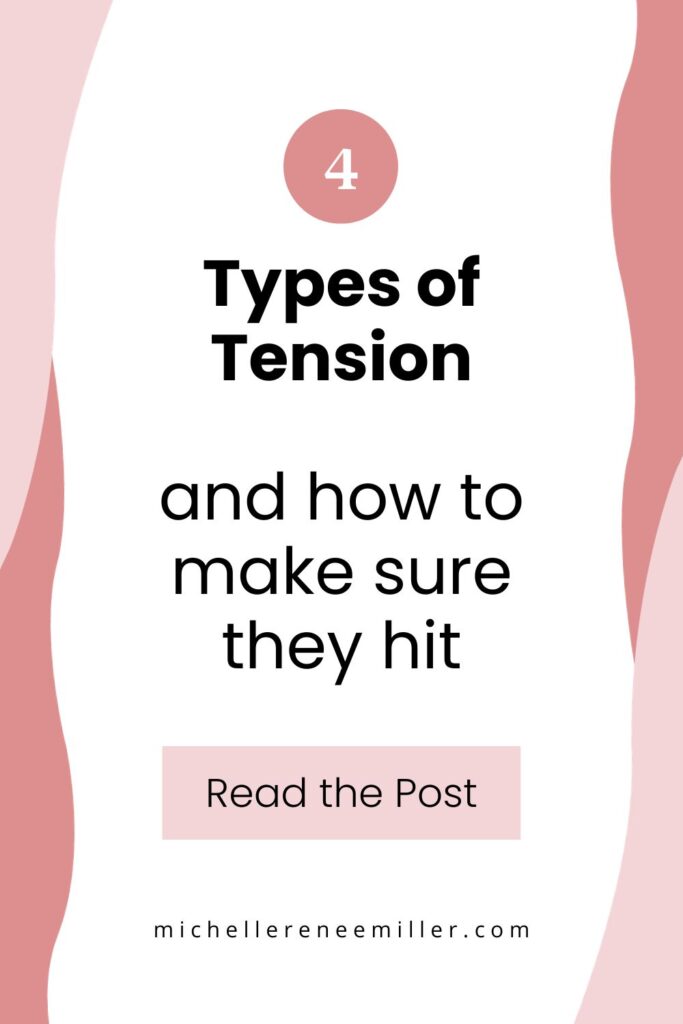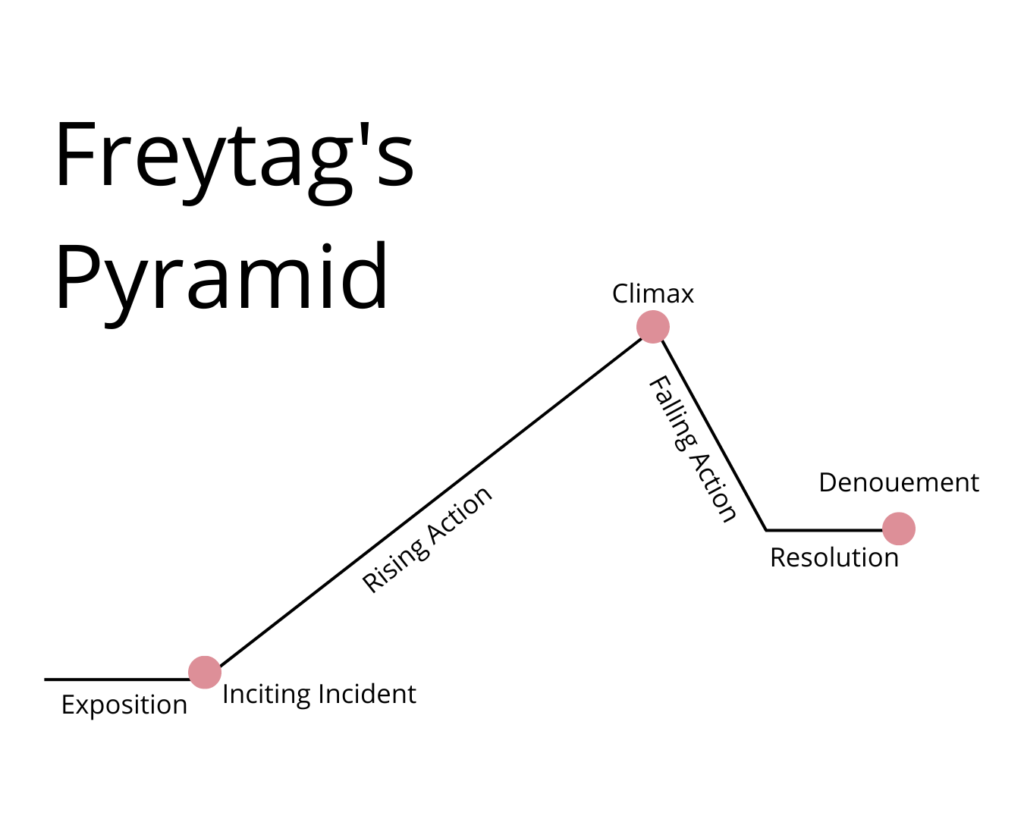4 Types of Tension and How to Make Sure They Hit
We’ve all heard the term ‘build tension in your story’, right? It’s a pretty common piece of writing advice, and for good reason. Without tension in your story, your reader isn’t going to care about too much. There are no stakes. But, building tension is more than just putting your character in sticky situations and hoping they make it out alive. Not only are there different types of tension, but there’s some ground work we need to lay that is less talked about.
What is tension building?
Building tension in a story means giving your readers something to be worried about. Will your main character fall in love? Will they get that thing they’re on a long quest to find?
But the real question is, how do we get the readers to care about that stuff? How do we get them to ask themselves, “Will it all work out?”
That comes before you add the sticky situations, what we might think of more noticeably as the tension in the story.
If you have a fight scene, but we don’t know who’s on either side, then the outcome really doesn’t matter. It’s like watching the Superbowl when you’ve never watched a game of football in your life. It’s supposed to be a big event and you should be biting your nails waiting to see who wins, but if you’re like me, you just don’t really care. There’s no tension, there’s no stakes to see who wins, it’s just another Sunday football game.
So before we talk about laying the groundwork for building tension, let’s look at the different types of tension you can include in your story.
The 4 types of tension
To get into what tension is we should take a moment to talk about what it’s not. We’re not necessarily talking about moments when someone says “you could cut the tension with a knife.” This is said usually after an argument, or when two people with a history come together by accident. There’s usually an incident that has occurred that’s led someone to say this phrase.
Now this kind of a situation can certainly be a point of tension in your story, however it’s not the only kind of tension. It’s probably not even the best or most exciting point of tension you could include. I want you to think much broader than these types of situations when you’re looking to add more tension into your story.
We’re going to talk about tension in relationships, tasks, surprises, and mysteries.
Relationships
The tension of relationships is when there’s some kind of tension between characters. Here’s where you might have a “you could cut the tension with a knife” moment. This is the main source of tension in romance novels. It’s when the antagonist gets in the way of the protagonist over and over.
This tension is important to include in your stories because it helps make your characters feel real. We get frustrated with other people almost every day in some way or another. So, your characters have to have similar issues.
And when we say tension of the relationships, it’s not only romantic relationships. This can be fights between friends, conflicts at work, awkward family dynamics. Any time two or more people are interacting, there’s a relationship there that can have tension.
Tasks
The tension of the task is all about the obstacles that show up when a character is trying to accomplish something. This can be for goals of any size.
Maybe in one section of your story your character is trying to get their car out of an icy parking spot, and there’s a meeting across town they have to make or they lose their job. There’s a few different instances of tension happening here. There’s the tension of the car being stuck, not knowing if it’ll get free. Then, there’s the tension of the time crunch, trying to get across town to make the meeting. Lastly, there’s the tension of potentially losing a job.
Including multiple tasks all on top of each other will double or triple your tension.
We want the character to figure it all out, and we’re watching to see if they make it. What will they do next?
Surprise
The next one is the tension of surprise. People who say they like surprises are only talking about gifts or vacations. Nobody really likes surprises.
Here, we have two different types of surprises. You can surprise the reader with a plot twist, or the you can surprise the protagonist with new events as they unfold.
Here’s a little secret I’ll share with you. Almost anything can be a plot twist.
Of course, some will carry more weight with them than others, but tension doesn’t have to be a big dramatic change in the story.
Your surprise could range from mom not being home when she usually is, to a meteor headed for earth that actually ends up being an alien spaceship.
If you think about it, there really isn’t a day that goes by where we aren’t surprised by something. Today I was surprised when my partner came home for lunch early. Sometimes I’m surprised by a car accident on the side of the road.
Surprises happen in many different sizes, but they happen everyday.
So again, much like the other tensions, you have to include surprises in your stories to make them feel realistic. A story that plays out exactly as expected is not worth reading. Your readers don’t want to be able to predict everything that happens next, that’s no fun.
Mystery
The last type of tension we’ll talk about is the tension of mystery.
This tension propels your reader forward in the story. The mystery is so enticing that they can’t not find out what happens. You can achieve this by building up with the other tensions to a cliffhanger that you then resolve later. You can have one overarching mystery that’s at play until the climax of the story. And you can have smaller mysteries that just keep popping up throughout the story.
And this mystery doesn’t have to be a big thing like a murder mystery. You can tie it to another type of tension, too. It can be the ‘will they won’t they’ trope in romance. The mystery of “will they make it across town to their meeting” can be enough.

Groundwork for the types of tension
So, now we know the types of tension you can include, but how do you lay the groundwork so that your tensions actually have an effect on your reader?
Creating substantial characters
I think the easiest way to lay the groundwork is to work on your characters. Now, working on characters itself isn’t necessarily easy, I won’t lie to you. But, it’s something you should already be working on as you write, so it’s not an extra step you need to add to make your tension work.
You really have to create substantial characters that your reader can follow and enjoy. You have to give your characters reactions to the tension that make sense and that are consistent with what you’ve done with them so far.
How to structure the types of tension in a story
If you’re not sure where to even start adding tension into your story, you might want to use a story structure at least for your first draft.
If you’ve been learning about creative writing for a while now, you might be familiar with Freytag’s Pyramid.

The exposition of your story can be pretty mild, you might start with some idea of a mystery. Then you get to your inciting incident, which is when the action starts. This is the Big Bang of the tension in your story. This moment will guide the rest of the story. The plot starts here. This could include any of the tensions, or maybe a combination of all four.
Then we have some rising actions. This is really where you lay in the tension thick. Now we’re building toward something. The mystery might get larger as we find more clues. The relationship might get rockier and rockier. The mission might get harder and harder to complete as more roadblocks show up.
Then we have the climax of the story. The characters solve the mystery, the relationship either ends or works out. The task fights one more big roadblock but is completed.
Then the resolution is generally tension-free. You wrap things up and the story is over. If you’re planning a sequel of some kind, then you might leave a hint of tension with a cliffhanger or a mere mention of what might be to come in the next book.
Concluding the types of tension
There are infinite ways you can take these 4 concepts of tension and create an intriguing story. Just remember to lay the groundwork as you go by building those realistic, relatable, and round characters. If you’re stuck, take a look at some different story structures. Chances are they have some tension built right into them.
Happy writing!
Get my free Character Profile Training!
Another great way to beat the tropes is to have round, relatable, and realistic characters. In under 15 minutes, this training will teach you how you should actually look at the character profile, and what to do with the information in it when it’s complete.
How does the information in the profile translate to the story you’re writing? Why do we need to know everything about our characters’ lives? And how does this tool help us write better stories?
If you’ve got less than 15 minutes, I’ve got the answers. Let me send this training to you!
Buy me a Chai?
I don’t drink coffee, but if you’re enjoying the blog posts I write, consider buying me a tea instead. All tips are greatly appreciated and allow me to continue bringing you free resources so you can be the best writer possible.




